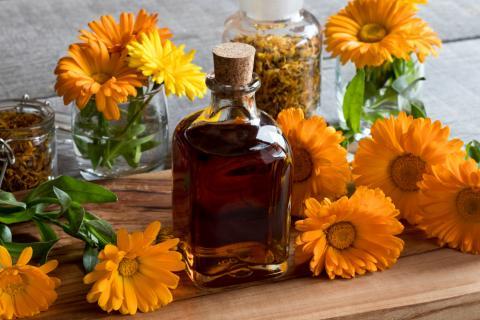
When I first started studying botanical medicine, I was at work and got a call from my then-boyfriend asking which plant in the yard was yarrow. He had cut his hand and wanted to do some first aid to stop the bleeding and prevent infection. This wasn’t the first time. Having a garden of first aid plants really comes in handy. Beyond adding beauty to your surroundings, you have at hand easy and effective remedies for everything from cuts and abrasions to insect bites, burns and digestive distress. Here are 5 must have first aid plants for your garden.
Yarrow (Achillea millefolium)
If you only had one plant on hand, yarrow is a good choice. It seems to do just about everything, so much so that I harvest the leaves and flowers throughout the growing season and dry it for use in the winter. I prefer to transplant wild yarrow for medicinal use, but if purchasing, you want to get the white-flowered variety. It should have a strong scent and taste both bitter and aromatic. A poultice, tea, dilute tincture, or infused honey are all good ways to apply it topically. Tea and tincture forms are best internally. Freshly ground powder added to water is also good. I’m not a huge fan of capsules.
Medicinal Uses
- Cuts, abrasions, burns, sunburns, stings, contusions—Stops bleeding, reduces pain, prevents infection, speeds healing.
- Diarrhea, food poisoning, cramping—Astringent targets infection and reduces gas and spasm.
- Urinary tract infection—Astringent that helps reduce bacterial attachment to bladder wall, reduces bleeding, targets infection, diuretic that helps flush out residual debris.
- Bruises, contusions—Clears blood/fluids
- Bug repellent
- Cold/flu—Reduces fever, aches and pains. Anti-microbial.
- Poison Ivy/Oak—The astringency helps dry up the rash, reduces itching.
- Internal bleeding—This requires a hospital visit, but if in the middle of nowhere, use yarrow to buy you some time.
Growth conditions
- Light—Full sun
- Soil—Tolerates wide range of soils, though prefers well-drained soil
- Watering—Doesn’t need frequent watering. In fact, you don’t want it too lush or it won’t be good medicine. Drought tolerant.
- USDA hardiness zones 4-8 (will survive down to -30°F)
- Propagation—Yarrow is a perennial and will spread both via roots and reseeding. Seeds can be planted directly in the garden.
Mallow (Malva neglecta, Malva silvestris, Althea officinalis, Aclea rosea, others)
Really, any mallow will do. And you can use the roots and leaves interchangeably. If your mallow is blooming, use the flowers too! Marshmallow does best in wet areas. Wild Mallow (Malva neglecta, M silvestris) may already be a “volunteer” in your garden or greenhouse and it needs little to no care. This is a plant you’ll find in bulldozed areas, vacant lots and the like. Hollyhock is a beautiful ornamental that’s also easy to grow and is great medicine. It also spreads pretty readily so you don’t have to feel guilty digging up some for the root. Globe mallow (Sphaeralcea species) is a beautiful addition for dry areas. Mallows can be used as a poultice and are great topically or internally as a tea (preferably a cold infusion).
Medicinal Uses
- Abrasions, burns, sunburn, rashes—Soothing, anti-inflammatory, immune stimulant, some anti-bacterial activity
- Splinters, stings—The leaves are great as a drawing poultice
- Respiratory soothing, immune-stimulating though not strong enough to use as a stand-alone herb
- Urinary tract infection—Soothing diuretic for flushing out debris, mild anti-bacterial effects but not strong enough to use alone
- Acid reflux—Reduces reflux and soothes mucus membranes
Growth conditions
- Light—Full sun to dapple shade.
- Soil—Tolerates wide range of soils
- Watering—All tolerate dry soil, but as mentioned, marshmallow won’t be good medicine without lots of water. Wild and Globe Mallows are drought tolerant.
- USDA hardiness zones: Marshmallow (zones 3 7), Wild Mallow (zones 4-8), Hollyhock (5-9), Globe Mallow (8-11)
- Propagation—These are perennials, though Hollyhock is susceptible to a fungal disease and is best grown as a biennial. They’re easy to grow from seed or root divisions.
Chamomile (Matricaria recutita)
Next to yarrow, chamomile is one of my other favorite plant medicines to have on hand. The flowers are gentle but effective. Aside from medicinal uses, chamomile is a pretty addition to the garden and makes a lovely beverage tea. It can also be used ground up and applied as a poultice or as a tincture.
Medicinal Uses
- Stings, burns, rashes—Reduces pain and inflammation
- Allergic reactions—Though very rarely someone is allergic to chamomile, it’s actually a useful anti-allergy herb and is usually in the seasonal allergy formulas I make.
- Indigestion, diarrhea—Reduces colic and other spasms, reduces digestive tract inflammation and is a gentle herb for loose stools in children
- Calming—Anyone who’s read Peter Rabbit knows chamomile is a great sleep aid. It’s also good for tension, anxiety, insomnia, and that special kind of peevishness children exhibit on long car trips.
- Eye irritation—Bagged chamomile tea as a compress is my go-to remedy for eye irritation. Simply soak briefly in water and apply. This has been useful on road trips…I was even able to find bagged tea in the coffee station of a gas station in the middle of nowhere.
Growth conditions
- Light—Likes full sun for at least part of the day
- Soil—While it likes well drained soils, it spread pretty happily in heavy clay soil here in Durango.
- Watering—Likes regular water but don’t overdo it or it won’t be as strong medicinally.
- USDA hardiness zones - 5-9
- Propagation—German Chamomile is annual that reseeds itself. Roman Chamomile (Anthemis nobilis) has similar uses and is a perennial. It gets leggy though, and is good grown instead as a biennial.
Calendula (Calendula officinalis)
Calendula is so easy to grow that mine spread in solid clay soil that only got watered from what came off the roof during a rain storm. It’s another pretty plant, with bright yellow to orange edible flowers (calendula-infused butter can be a topic for a future article). I prefer calendula as a tincture for internal use and a dilute tincture, infused oil, or poultice topically.
Medicinal Uses
- Burns, sunburn, abrasions—Anti-bacterial, wound healing. Though don’t use on deep wounds…it works so quickly it may seal the surface of the wound before it’s healed underneath.
- Bruises, contusions—Will help clear our blood and fluids from the area.
- Ringworm, athlete’s foot, candida overgrowth—A good anti-fungal that is safe for long term use.
- Poison Ivy/Oak—Astringency will help dry rash while anti-inflammatory properties will soothe.
- Sprains/strains—Anti-inflammatory for bringing down swelling
Growth conditions
- Light—Full to part sun
- Soil—Tolerates wide range of soils (it spread in solid clay that only got water when it rained)
- Watering—They don’t need much water—you can get away with once a week, but a little more will encourage blooming
- USDA hardiness zones - 3-10
- Propagation—Annual that readily reseeds. Grows just fine in a wide range of soils
Lavender (Lavandula angustifolia)
Aside from its lovely scent and beautiful flowers and foliage, lavender is a top notch first aid plant. In fact, if I could only have one essential oil, lavender would be it. But the flowers and leaves are just fine in place of the essential oil…after all, they’re where it comes from! It’s a bit hard to get down as a straight tea and is better blended with other herbs if taking it that way. I like it as a tincture for internal use and an infused oil, tea, or dilute tincture topically.
Medicinal Uses
- Cuts, abrasions, burns, sunburn, stings—Antiseptic, pain-relieving, wound healing. I’ve used lavender many times for cuts and burns…a frequent occurrence when I ran my cafe and would be in a rush.
- Shingles and cold sores—Anti-viral and pain-relieving. A client able to stop her narcotic prescription for shingles with a simple lavender and St. John’s wort topical.
- Bug repellent
- Cold/flu—Anti-microbial, soothing. Lavender-infused olive oil makes a great chest and back rub, especially for irritating, painful coughs
- Indigestion, food poisoning—The aromatics of lavender are strongly anti-microbial and also help relieve gas and cramping.
Growth conditions
- Light—Full to part sun
- Soil—Does well in light, sandy soil, but also grew in my amended clay soil. Overly rich soil will weaken the medicine.
- Watering—Drought tolerant once established. Water deeply but not too frequently. Overwatering will reduce medicinal strength.
- USDA hardiness zones - 5-8. The Munstead cultivar does well in dry climates with extreme temperature changes (like where I live in Durango).
- Soil—Well-drained soil, amended if heavy soil. Typically, the plant does better in light soils, but it grew just fine in my heavy, amended clay soil.
- Propagation—Can start from seed, but most easily from cuttings or root divisions. Plus, cuttings will allow you to preserve the properties of a plant whose characteristics you really like. You can take a cutting in the summer and grow in a cold frame or greenhouse the first winter to help it get established.
There are many other great plants that could be added to the list, but these 5 cover a wide range of issues and are a great place to start!








